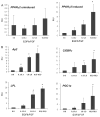Culture effects of epidermal growth factor (EGF) and basic fibroblast growth factor (bFGF) on cryopreserved human adipose-derived stromal/stem cell proliferation and adipogenesis
- PMID: 19670348
- PMCID: PMC2763318
- DOI: 10.1002/term.198
Culture effects of epidermal growth factor (EGF) and basic fibroblast growth factor (bFGF) on cryopreserved human adipose-derived stromal/stem cell proliferation and adipogenesis
Abstract
Previous studies have demonstrated that EGF and bFGF maintain the stem cell properties of proliferating human adipose-derived stromal/stem cells (hASCs) in vitro. While the expansion and cryogenic preservation of isolated hASCs are routine, these manipulations can impact their proliferative and differentiation potential. This study examined cryogenically preserved hASCs (n = 4 donors), with respect to these functions, after culture with basic fibroblast growth factor (bFGF) and epidermal growth factor (EGF) at varying concentrations (0-10 ng/ml). Relative to the control, cells supplemented with EGF and bFGF significantly increased proliferation by up to three-fold over 7-8 days. Furthermore, cryopreserved hASCs expanded in the presence of EGF and bFGF displayed increased oil red O staining following adipogenic induction. This was accompanied by significantly increased levels of several adipogenesis-related mRNAs: aP2, C/EBPalpha, lipoprotein lipase (LPL), PPARgamma and PPARgamma co-activator-1 (PGC1). Adipocytes derived from EGF- and bFGF-cultured hASCs exhibited more robust functionality based on insulin-stimulated glucose uptake and atrial natriuretic peptide (ANP)-stimulated lipolysis. These findings indicate that bFGF and EGF can be used as culture supplements to optimize the proliferative capacity of cryopreserved human ASCs and their adipogenic differentiation potential.
Copyright (c) 2009 John Wiley & Sons, Ltd.
Conflict of interest statement
Dr Gimble consults or collaborates with the following tissue engineering-related companies: Toucan Capital, Cognate Bioservicese, Vesta Therapeutics and Zen-Bio.
Figures




References
-
- Adachi H, Kurachi H, Homma H, et al. Epidermal growth factor promotes adipogenesis of 3T3-L1 cell in vitro. Endocrinology. 1994;135:1824–1830. - PubMed
-
- Butterwith SC, Peddie CD, Goddard C. Regulation of adipocyte precursor DNA synthesis by acidic and basic fibroblast growth factors: interaction with heparin and other growth factors. J Endocrinol. 1993;137:369–374. - PubMed
-
- de Boer F, Drager AM, Pinedo HM, et al. Extensive early apoptosis in frozen-thawed CD34-positive stem cells decreases threshold doses for haematological recovery after autologous peripheral blood progenitor cell transplantation. Bone Marrow Transpl. 2002;29:249–255. - PubMed
-
- Devireddy RV, Thirumala S, Gimble JM. Cellular response of adipose-derived passage-4 adult stem cells to freezing stress. J Biomech Eng. 2005;127:1081–1086. - PubMed
-
- Goh BC, Thirumala S, Kilroy G, et al. Cryopreservation characteristics of adipose-derived stem cells: maintenance of differentiation potential and viability. J Tissue Eng Regen Med. 2007;1:322–324. - PubMed
Publication types
MeSH terms
Substances
Grants and funding
LinkOut - more resources
Full Text Sources
Other Literature Sources
Research Materials

